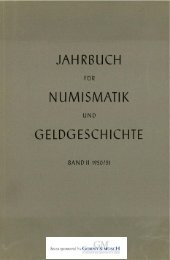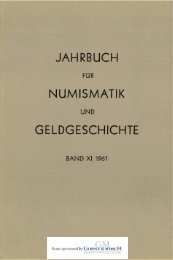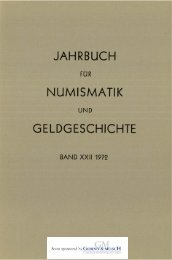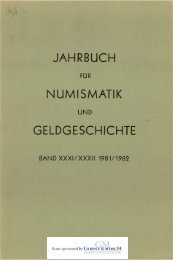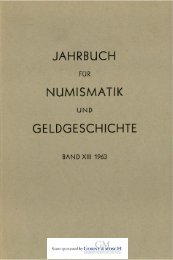26 David MacDonaldtype in the fourth century. The Cretan cities Elyros and Polyrhenionemployed it late in the fourth or early in the early third century. It even appearedon an Achaemenid satrapal issue from Tarsos in Cilicia.13The Chi surcharge on the shield (1') cannot even be assumed with certaintyto represent Chalkis. Despite assertions to the contrary, the form of the letteris not distinctively Chalkidian or even Euboian, but rather appears in anumber of archaic Greek local scripts including that of Boiotia. This is onlyto be expected. Despite the tradition of Kadmos' introduction of writingfrom Phoenicia, it appears that Boiotia received its alphabet from Euboia."Alphabetic shield blazons bearing the initial letter of a city's ethnic appeartoward the end of the fifth or early in the fourth century,15 but there seemto be no other instances of shields charged with a City ethnic or initial oncoins. An alphabetic shield blazon on a coin of the late fifth or early fourthcentury represents a dynast's name rather than an abbreviation of a cityethnic.16 The significance of the letter on the shield/wheel issue remainsuncertain. It may stand for Chalkis, or for something else entirely, such asa magistrate's initial. Isolated letters of uncertain significance appear on a13Salamis: BMC Attica p. 116 nos. 1-11, representing the shield of Ajax; Tarsus: BMC Lycaoniap. 175 no. 79, time of Mazaeus. In addition, the heroic shield also appears as an adjuncttype, probably representing the individual badge of a magistrate, on coins of Leukas(BMC Corinth pl. XXXV, 8), Thyrrheion (BMC Corinth pl. XXXVIII, 12), on postumoustetradrachms of Philip II and Alexander from the Pella mint, (G. LeRider, Le monnayaged'argent et d'or de Philippe II, Paris 1977, Pella mint nos. 528-534), and on still morediverse issues: Imhoof-Blumer, Monnaies grecques, 221-224. For the general significanceof the "Boiotian" shield, L. Lacroix, Le bouclier, embleme des Beotiens, RBPhil 1958,5-30, and L. Lacroix, A propos des representations de boucliers sur les monnaies grecques,Centennial Publication of the American Numismatic Society, New York 1958, 401-406.The shield may have been adopted as a coin type initially because its ovoid form resembledthe turtle of Aigina. Early coins of Aiginetan weight tended toward turtle-shaped types, e.g.Melos — apple or vase, Naxos — cantharus, Coressia — squid, Andros — amphora, etc.14L.H. Jeffery, The Local Scripts of Archaic Greece, Oxford 1961, 79-83, 89-95, Table ofLetters, following Plate 72. For use of the "Chalkidian" Chi on Boiotian coins well intothe fourth century, BMC Central Greece p. 82 no. 141-142.15The Lakedaemonians used a A on their hoplite shields; Messenians M, Sikyonians E,Thebans a club, and Mantineans a trident. A or AOE variously arranged appear on shieldon a number of Attic vases, often in athletic contexts. G.H. Chase, The Shield Devices ofthe Greeks, HarvSt, 1902, 87, 110-111; A.M. Snodgrass, Arms and Armour of the Greeks,Ithaca 1967, 67.16 Dynast: Kherriga of Xanthos: 0. Merkholm and J. Zahle, The Coinages of the LycianDynasts Kheriga, Kherei and Erbbina, ActaArch 1976, p. 50 no. 31: Obv.: Helmeted headof Athena r. Rev.: Athena sitting r. with shield bearing (Y) and Lycian legend consistingof the name of Kheriga and the Lycian name of Xanthos. The shield blazon cannot standfor the initial of Xanthos; the Lycian name of that city was Arnnahe. Similarly, Pyrrhus'monogram appears on a shield on some of his coins (BMC Thessaly to Aetolia p. 113 nos.36-39) and the monogram of Achilles on a shield held by Thetis (BMC Thessaly to Aetoliap. 33 nos. 1-2: Larissa Cremaste).
Significance of „Boiotian League/Chalkis" Silver Issue 27number of archaic Greek coins. Even if it is assumed to stand for Chalkis,there is no reason to assume it indicates a political combination with theBoiotian League.A wheel appears as the reverse type on some of Chalkis' early coinage, butit is not the only or even the characteristic reverse type. The wheel on theshield/wheel coin, moreover, is not exactly like the wheel on any issue thatis certainly from Chalkis. W.P. Wallace has pointed out that "this is the onlyChalkis wheel to have an axle-hole, and its fabric seems more Eretrian thanChalkidian."17 A wheel appears on a number of other contemporarycoinages, including Makedonian issues of a style generally similar to Euboiancoinages and the shield/wheel issue."The Berlin specimen is clipped; its original weight cannot be ascertained.The Paris specimen weighs 16.80 g, in reasonable agreement with both theEuboian and Attic standards for the stater.'9 The stater weighs the sametheoretical 17.2 g in both standards, but the Euboian stater was divided intothirds and sixths while the Attic was divided into halves and quarters. In theabsence of fractional denominations, the two standards cannot bedistinguished. Euboian cities first struck coins to the Euboian standard butchanged to the Attic system of divisions before 500 B.C. The Chalkidikesimilarly changed from the Euboian to the Attic system of fractions at anearly date. Both the Euboian and Attic standards were, of course, alsoemployed elsewhere. Boiotia coined to the Aigenitic standard rather than theEuboian, but the first certain Boiotian coins of Aigenitic standard were notstruck until a decade or more after the shield/wheel issue.2° It is not beyondpossibility that some Boiotian city, perhaps Tanagra, employed the Euboianstandard for an abortive issue considerably before it commenced regularcoinage.Despite these doubts, it is likely that the shield/wheel issue was in factstruck at Chalkis sometime around 520 B.C. Style, fabric, and weight agreebetter with contemporary Euboian issues than with any others. Salvaging theprobable Chalkidian origin of the issue does not, however, resurrect17W.P. Wallace, "Early," p. 38 n. 2.18E.g. coins of the Ichnai (BMC Macedonia p. 76 no. 1; Price and Waggoner, Asyut, nos.40-44), other Thraco-Macedonian issues (BMC Macedonia pp. 154-155 nos. 16-21), aswell as the EMINAKO coins from Olbia (Babelon, Traite 113, Paris 1912, 272, giving theissue to Thrace; modern opinion is in favor of Olbia as the mint.) These coinages, of course,are struck to different weight standards from the Attic-Euboian standard of theshield/wheel issue. Wheel types are common throughout the Greek world, from Massaliathrough Baktria.19The coin has suffered a test cut on the obverse, which should not have altered its weight.The loss of 0.4 g is most likely due to corrosion, which affected many of the coins in theTaranto hoard greatly. Kraay, Archaic, 88-91, 329-330.20 Note 11 supra.
- Seite 1: JAHRBUCHFÜRNUMISMATIKUNDGELDGESCHI
- Seite 5 und 6: JAHRBUCHFÜRNUMISMATIK UND GELDGESC
- Seite 7 und 8: INHALTVorbemerkung der Redaktion 7G
- Seite 9: 7Vorbemerkung der RedaktionEntgegen
- Seite 12 und 13: 10 Gerd DethlefsDie Zeichnung befin
- Seite 14 und 15: 12 J.Elayi, A.G.Elayiexplicit inscr
- Seite 16: 14 J. Elayi, A.G.Elayione bears on
- Seite 19 und 20: Abbreviations Used by Byblos,Tyre a
- Seite 21 und 22: Abbreviations Used by Byblos,Tyre a
- Seite 23 und 24: Abbreviations Used by Byblos,Tyre a
- Seite 25 und 26: Jahrbuch f. Numismatik u. Geldgesch
- Seite 27: Significance of „Boiotian League/
- Seite 31: Significance of „Boiotian League/
- Seite 34 und 35: 32 Peter F. Dorceycoinage. Accordin
- Seite 36 und 37: 34 Peter F. Dorceyquem of 120.'° A
- Seite 38 und 39: 36 Peter F.DorceyEETI(AI)2° and HP
- Seite 40 und 41: 38 Peter F. DorceyTable I: Catalogu
- Seite 42 und 43: 40 Peter F.DorceyTable II: Coin Hoa
- Seite 44 und 45: 42 Allan A. LundDer Germanenbegriff
- Seite 46 und 47: 44 Allan A. Lundnen sie, wie die Fo
- Seite 48 und 49: 46 Allan A. Lunddie Angaben über d
- Seite 50 und 51: 48 Allan A. Lundw a 200 Kilometer b
- Seite 52 und 53: 50 Allan A. Lundrelle Grenze fielen
- Seite 55 und 56: Jahrbuch f. Numismatik u. Geldgesch
- Seite 57 und 58: Ein weiterer Aureus des Pescennius
- Seite 59 und 60: Jahrbuch f. Numismatik u. Geldgesch
- Seite 61 und 62: 1Bronzeprägung von Laodikeia in Sy
- Seite 63 und 64: Bronzeprägung von Laodikeia in Syr
- Seite 65 und 66: Bronzeprägung von Laodikeia in Syr
- Seite 67 und 68: Bronzeprägung von Laodikeia in Syr
- Seite 69 und 70: Bronzeprägung von Laodikeia in Syr
- Seite 71 und 72: Bronzeprägung von Laodikeia in Syr
- Seite 73 und 74: Bronzeprägung von Laodikeia in Syr
- Seite 75 und 76: Bronzeprägung von Laodikeia in Syr
- Seite 77 und 78: Bronzeprägung von Laodikeia in Syr
- Seite 79 und 80:
Bronzeprägung von Laodikeia in Syr
- Seite 81 und 82:
Bronzeprägung von Laodikeia in Syr
- Seite 83 und 84:
Bronzeprägung von Laodikeia in Syr
- Seite 85 und 86:
Bronzeprägung von Laodikeia in Syr
- Seite 87 und 88:
Bronzeprägung von Laodikeia in Syr
- Seite 89 und 90:
Bronzeprägung von Laodikeia in Syr
- Seite 91 und 92:
Bronzeprägung von Laodikeia in Syr
- Seite 93 und 94:
Bronzeprägung von Laodikeia in Syr
- Seite 95 und 96:
Jahrbuch f. Numismatik u. Geldgesch
- Seite 97 und 98:
Zwei Bleigewichte in München 95mei
- Seite 99 und 100:
Zwei Bleigewichte in München 97Val
- Seite 101 und 102:
Zwei Bleigewichte in München 99nö
- Seite 103 und 104:
Jahrbuch f. Numismatik u. Geldgesch
- Seite 105 und 106:
Saalfeld als Münzstätte der Leini
- Seite 107 und 108:
Saalfeld als Münzstätte der Leini
- Seite 109 und 110:
Saalfeld als Münzstätte der Leini
- Seite 111 und 112:
Saalfeld als Münzstätte der Leini
- Seite 113 und 114:
Saalfeld als Münzstätte der Leini
- Seite 115 und 116:
Saalfeld als Münzstätte der Leini
- Seite 117 und 118:
Saalfeld als Münzstätte der Leini
- Seite 119 und 120:
Saalfeld als Münzstätte der Leini
- Seite 121 und 122:
Saalfeld als Münzstätte der Leini
- Seite 123 und 124:
Saalfeld als Münzstätte der Leini
- Seite 125 und 126:
Saalfeld als Münzstätte der Leini
- Seite 127 und 128:
Saalfeld als Münzstätte der Leini
- Seite 129 und 130:
Saalfeld als Münzstätte der Leini
- Seite 131 und 132:
129ZUSAMMENFASSUNGEN(erstellt von B
- Seite 133 und 134:
Zusammenfassungen/Conclusions 131Ar
- Seite 135 und 136:
Jahrbuch f. Numismatik u. Geldgesch
- Seite 137 und 138:
Buchbesprechungen, Jb.f.Num.u.Geldg
- Seite 139 und 140:
Buchbesprechungen, Jb.f.Num.u.Geldg
- Seite 141 und 142:
Buchbesprechungen, Jb.f.Num.u.Geldg
- Seite 143:
Buchbesprechungen, Jb.f.Num.u.Geldg
- Seite 146 und 147:
144 Jahresbericht Staat!. Münzsamm
- Seite 149 und 150:
Jahrbuch f.Numismatik u. Geldgeschi
- Seite 151 und 152:
Jahresbericht B.N.G. 149Stadt lasse
- Seite 153:
Jahresbericht B.N.G. 151Band 35, k
- Seite 156 und 157:
154 Jahresbericht B.N.G.der Heimat
- Seite 158 und 159:
156 Jahresbericht B.N.G.Medaillen"
- Seite 161 und 162:
vyaltoti9er canyexitift, _s,9t.czr
- Seite 163 und 164:
Tafel 3123Zu: J. und A.G. Elayi, Sy
- Seite 165:
Tafel 5Zu: Peter F. Dorcey, The Pos
- Seite 169 und 170:
Zu: Eckhard Meyer, Die Bronzeprägu
- Seite 171 und 172:
Elf el 949Zu: Eckhard Meyer, Die Br
- Seite 173 und 174:
Zu: Eckhard Meyer, Die Bronzeprägu
- Seite 175 und 176:
Zu: Eckhard Meyer, Die Bronzeprägu
- Seite 177 und 178:
Zu: Eckhard Meyer, Die Bronzeprägu
- Seite 179 und 180:
Zu: Eckhard Meyer, Die Bronzeprägu
- Seite 181 und 182:
Tafel 19Maßstab:1 : 1Foto: Staatl.
- Seite 183 und 184:
Tafel 211 2 34 5. , )(4. ' cili li





